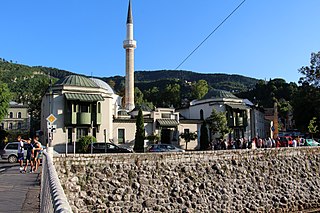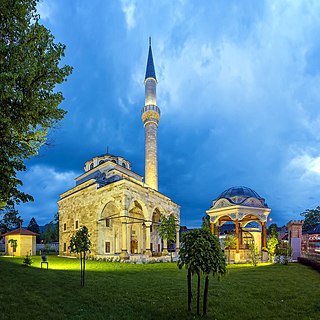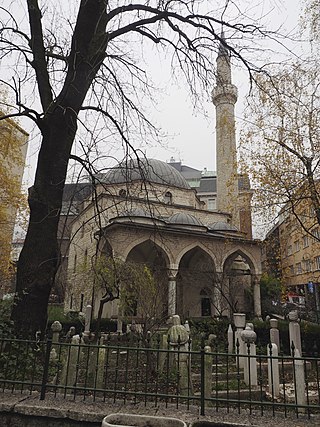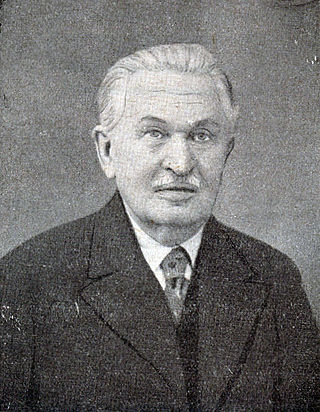
Gazi Husrev-beg Mosque is a mosque in the city of Sarajevo, Bosnia and Herzegovina. Built in the 16th century, it is the largest historical mosque in Bosnia and Herzegovina and one of the most representative Ottoman structures in the Balkans. Being the central Sarajevo's mosque since the days of its construction, today it also serves as the main congregational mosque of the Muslims in Bosnia and Herzegovina. It is located in the Baščaršija neighborhood in the Stari Grad municipality and, being one of the main architectural monuments in the town, is regularly visited by tourists.

The Emperor's Mosque is an important landmark in Sarajevo, Bosnia and Herzegovina, being the first mosque to be built (1457) after the Ottoman conquest of Bosnia. It is the largest single-subdome mosque in Bosnia and Herzegovina, built in the classical Ottoman style of the era.

Istiqlal Mosque in Jakarta, Indonesia is the largest mosque in Southeast Asia and the sixth largest mosque in the world in terms of worshipper capacity. Built to commemorate Indonesian independence, this national mosque of Indonesia was named "Istiqlal", an Arabic word for "independence". The mosque was opened to the public on 22 February 1978. Within Jakarta, the mosque is positioned next to Merdeka Square and the Jakarta Cathedral (Catholic) and also of the Immanuel Church (Reformed).

Ferhat Pasha Mosque, also known as the Ferhadija Mosque, is a mosque in the city of Banja Luka and one of the greatest achievements of Bosnia and Herzegovina's 16th century Ottoman Islamic architecture. The mosque was demolished in 1993 at the order of the authorities of Republika Srpska as a part of ethnic cleansing campaign, and was rebuilt and opened on 7 May 2016.
Istiqlal means independence and may refer to:

Türbe is the Turkish word for "tomb". In Istanbul it is often used to refer to the mausolea of the Ottoman sultans and other nobles and notables.
The architecture of Bosnia and Herzegovina is largely influenced by four major periods, when political and social changes determined the creation of distinct cultural and architectural habits of the region.

Ali Pasha Mosque was constructed in Sarajevo, Bosnia and Herzegovina during 1560–61 as a vakıf—the legacy or perpetual endowment—of Sofu Hadım Ali Pasha, an Ottoman statesman who served as the governor of the Bosnia Eyalet of the Ottoman Empire amongst other roles, after his death in September 1560.

Jakarta Cathedral is a Roman Catholic cathedral in Jakarta, Indonesia, which is also the seat of the Roman Catholic archbishop of Jakarta, currently Archbishop Ignatius Suharyo Hardjoatmodjo. Its official name is Gereja Santa Maria Diangkat ke Surga, derived from the original name in Dutch, De Kerk van Onze Lieve Vrouwe ten Hemelopneming. This current cathedral was consecrated in 1901 and built in the neo-Gothic style, a common architectural style to build churches at that time. The Jakarta Cathedral is located in Central Jakarta near Merdeka Square and Merdeka Palace, right in-front of the cathedral stands the Istiqlal Mosque.

Moth ki Mosque is a heritage building located in Delhi, and was built in 1505 by Wazir Miya Bhoiya, Prime Minister during the reign of Sikander Lodi (1489–1517) of the Lodi dynasty. It was a new type of mosque developed by the Lodis in the fourth city of the medieval Delhi of the Delhi Sultanate. The name of the mosque literally translated into English language means ‘Lentil Mosque’ and this name tag ‘Lentil’ has an interesting legend. This mosque was considered a beautiful Dome (Gumbad) structure of the period.

Ferhadija Mosque, also known as Ferhat Pasha Mosque, is a central building in the city of Sarajevo built by Bosnian Sanjak-bey (governor) Ferhad-beg Vuković, a descendant of the famous mediaeval Vuković family. This mosque has one dome above the prayer area and three small domes at the cloister and is one of the greatest achievements of Bosnia and Herzegovina’s 16th century Ottoman and Islamic architecture.

Karel Pařík was a Czech-born architect in the Austro-Hungarian empire. Pařík spent most of his life in Sarajevo where he designed over seventy major buildings, which are today classified among the most beautiful in Bosnia and Herzegovina. For Bosnians, he is also known as Karlo Paržik and is considered as "The builder of Sarajevo". He died working on his last project, Sarajevo City Hall, which later became one of the symbols of the city. "Czech by birth, Sarajevan by choice" stands encrypted on his gravestone in Sarajevo.
The Gurbanguly Hajji Mosque is a mosque in Mary, Turkmenistan. It was completed in 2009, during the rule of Gurbanguly Berdimuhamedov. It is a prominent landmark in Mary with its four minarets.

Bosnia and Herzegovina–Indonesia relations refers to the bilateral relations of Bosnia and Herzegovina and Indonesia. Bosnia and Herzegovina has an embassy in Jakarta, while Indonesia has an embassy in Sarajevo. The bilateral relations was initially motivated by humanity and religious solidarity. As a nation with the largest Muslim population, Indonesians were shocked by the ethnic cleansing against Muslim Bosniaks during the Bosnian War, and promptly organized and mobilized help. Indonesian support for Bosnia and Herzegovina ranged from collecting donations, sending peacekeeping forces under United Nations, to building the Istiqlal Mosque in Sarajevo.
Istiqlal Mosque may refer to:

Al-Azhar Great Mosque is a mosque located in Jalan Sisingamangaraja, Kebayoran Baru, Jakarta. The mosque was constructed between 1953 and 1958. It was originally known simply as Mesjid Agung. It was Jakarta's largest mosque when it was built until it was surpassed by the Istiqlal Mosque which was completed in 1978. Al-Azhar mosque and the mosque complex is best known for its educational works.

Al-Akbar National Mosque of Surabaya, also known as Al-Akbar Mosque or Great Mosque of Surabaya, is a national mosque located in Surabaya, East Java. It is the second largest mosque in Indonesia after Istiqlal Mosque in Jakarta in terms of maximum capacity. The location of the mosque is beside the Surabaya-Gempol Highway. Its most distinctive feature is its large vertical dome, accompanied by four small blue domes. It also has a minaret with height of 99 meters, an ode to the 99 Names of Allah.
February 2017 Jakarta protests refer to a series of mass protest led by Islamist movements which took place on 11 February 2017 and 21 February 2017 in Jakarta, Indonesia, and dubbed as the Action 112 and the Action 212 respectively. The protests were aimed against the incumbent Governor of Jakarta Special Capital Region Basuki Tjahaja Purnama for an alleged blasphemy of the Quran, the Islamic holy book.

Mosque architecture in Indonesia refers to the architectural traditions of mosques built in the archipelago of Indonesia. Initial forms of the mosque, for example, were predominantly built in the vernacular Indonesian architectural style mixed with Hindu, Buddhist or Chinese architectural elements, and notably didn't equip orthodox form of Islamic architectural elements such as dome and minaret. Vernacular architectural style varies depending on the island and region.

Al Jabbar Grand Mosque is a mosque located in Bandung, West Java, Indonesia. Due to the fact that it is around by a reservoir, the mosque is sometimes referred to as the Al Jabbar Floating Mosque. The mosque is adjacent to Summarecon Bandung and is situated in the Gedebage district in eastern Bandung.



















